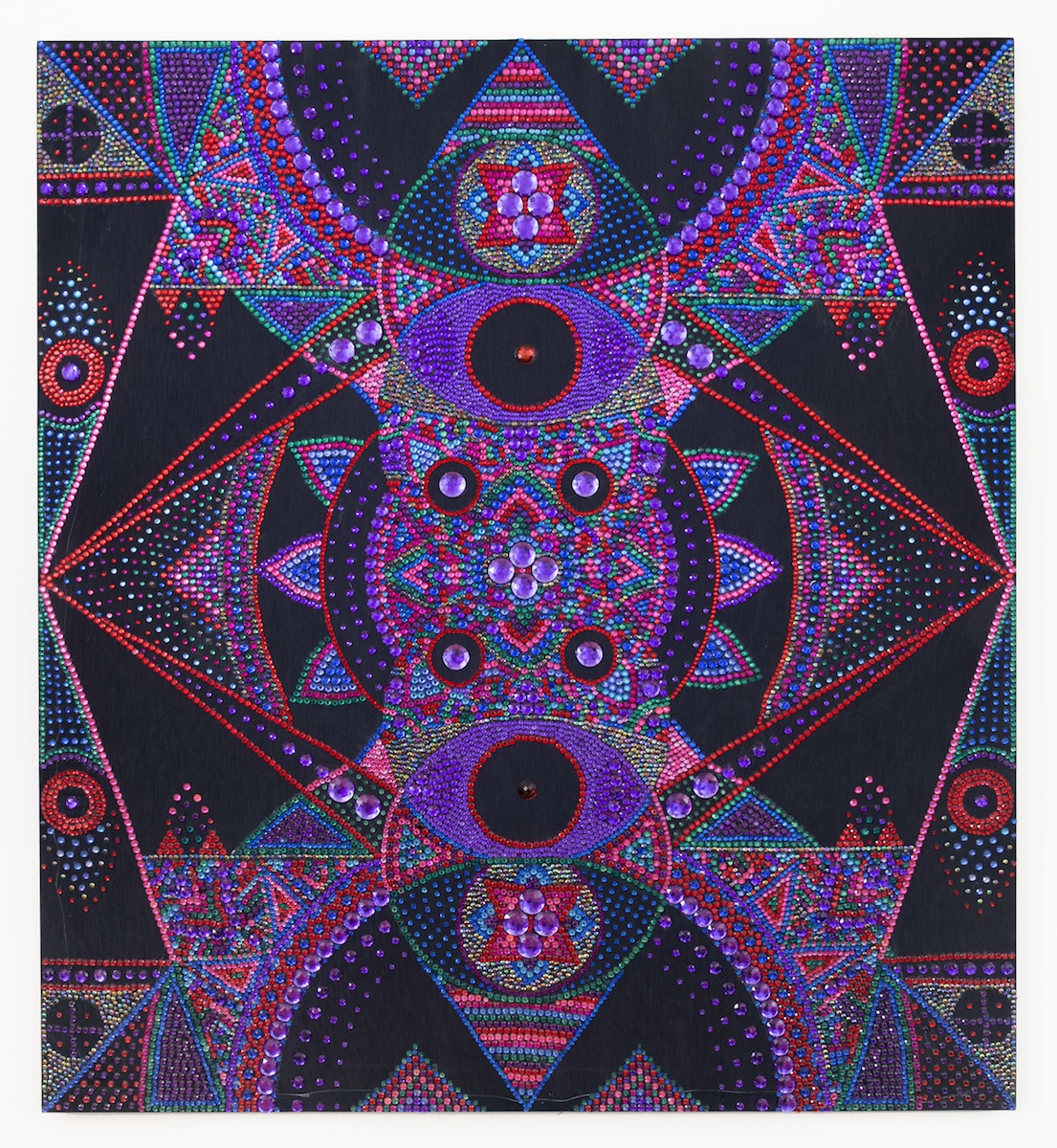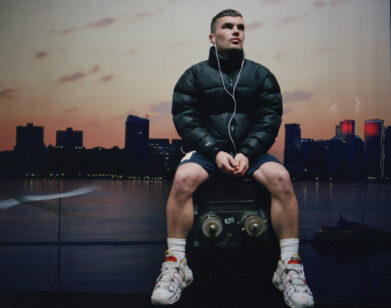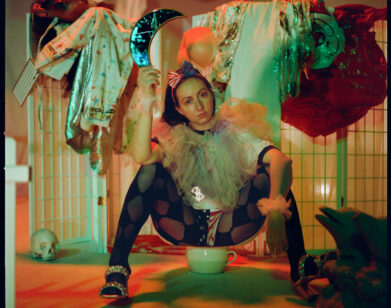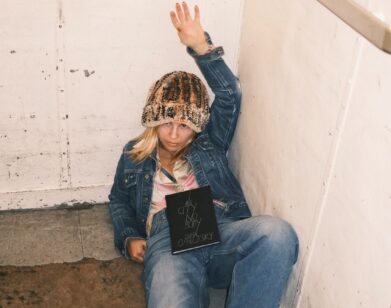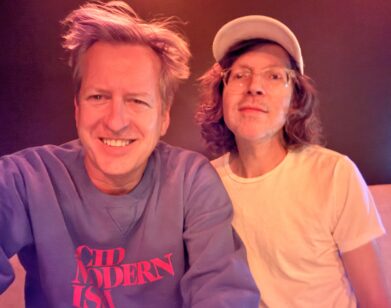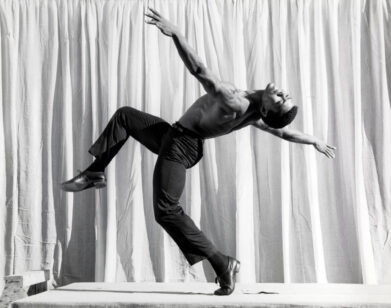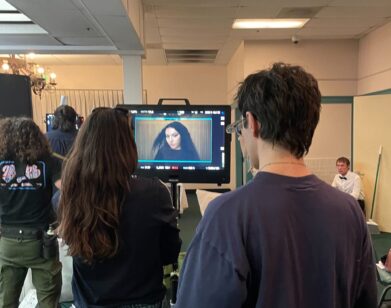The Bedazzling Evie Falci
The last time we saw this much jeweled denim was in a Delia’s catalogue or Destiny’s Child music video—but Brooklyn-based artist Evie Falci does it much better. Her pieces, large-scale denim- and leather-covered canvases with intricate, mosaic-like embellishments in rhinestones and studs, are a little bit disco, a little bit ancient architecture, a little bit craft-inspired, and a whole lot of interesting. Her show “Everything All Night” opens tomorrow at the Jeff Bailey Gallery, so we sat down with her to talk about the importance of dressing up, feminist gestures, and why Jeff Koons is so damn soulless.
KAYLA TANENBAUM: What came first, your interest in beauty and fashion or your interest in art?
EVIE FALCI: Art, first and foremost. I’m a person in the world; I don’t make art for other artists. I draw from many different sources and interests that I have, and obviously fashion and beauty is one of them, but I think one of the challenges that I find in my work is that I use a lot of materials that could come across as kind of kitschy or superficial. It’s interesting for me to take things that could be dismissed and make them really powerful and undeniable in their beauty and color.
TANENBAUM: How does your art influence your personal aesthetic—the way you dress or apply makeup—and vice versa?
FALCI: When I’m going out to see and be seen, I think that having drama, impact, just having game is really important. Especially because I feel like so many people try to do this “cool” look, but it’s also kind of casual, which is fine, but I think it’s more exciting to be a bit more theatrical. There’s this woman I saw on Advanced Style, she was talking about the art of dressing and to dress well and dress beautifully elevates your personal consciousness and those around you, because people can tell when you give a damn. I don’t want to live in Sweatpants Nation.
TANENBAUM: Do you think your work has a subversive quality? Because when I think rhinestones and denim, my first thought is not high art, but you render it beautiful.
FALCI: The work came about—before I was making craft materials linked to children’s crafts—but I was collecting rhinestones, and I had this lightbulb moment where I realized denim would be the natural arena for these materials to do their thing. The studs on leather were the natural counterbalance to that, the masculine to the feminine and also, formally the black and white of the silver as relating to drawing—tone, versus the rhinestones as pigments and paint.
TANENBAUM: How do you think the new different materials are in conversation with each other?
FALCI: I feel they balance each other out and are natural opposites, in a way. At the same time, they’re similar, both in terms of the application of individual units and also the way they function in culture as a way of identifying your tribe.
TANENBAUM: You said you drew inspiration not just from textiles. What else?
FALCI: I find a lot of inspiration from the ancient world, walking through the Egyptian, Sumerian, Greek halls of the Met.
TANENBAUM: Would you say that when you’re thinking about a project it’s very deliberate, or is it more organic?
FALCI: Definitely more organic. I don’t sketch; I don’t plan what’s going to happen ahead of time. It’s always a surprise what happens, and it’s kind of just getting into the moment, how I’m feeling. It functions as a type of meditation. With this recent body of work, though, I’m more deliberate about the color palette.
TANENBAUM: Is there a specific work or region you looked to more than others for these pieces?
FALCI: I was doing a lot of research on Islamic mosaic work and carpets, but it’s not only from that tradition. I also looked at textiles from India and South America.
TANENBAUM: I saw the mosaic-like quality. Are you consciously engaging with femininity in your work?
FALCI: Definitely. Rhinestones aren’t a masculine material. Richard Serra is the most butch artist for using iron and steel, so there’s an obvious feminine connotation to it. At the same time, it naturally has a relationship to quilts and textiles, women’s crafts in a traditional sense. I guess you can read a feminist gesture in the work, but I’m trying to make things that are so aggressively beautiful that they’re not just girly. I’m trying to give these things real power, so if it is feminine, it’s a divine femininity.
TANENBAUM: I saw that feminist gesture in your work, too, because there’s so much discourse in the art world about being male-dominated. You’re going ahead and making these pretty massive pieces that use materials male artists might put down as more craft than art. It’s a bold kind of fuck-you.
FALCI: That’s absolutely one of the things that I’m doing. I also feel like not only am I trying to assert that beauty is important and it is not just superficial or frivolous, but also that it’s powerful and it’s meaningful. Also emphasizing the element of craft and labor, that you can see my hand in this work. There’s no smoke and mirrors. It’s pretty obvious how I make these things. I find value in things that take a long time, take a lot of care in making. I feel like there’s a real trend of slacker minimalism, or work that’s made predominantly out of garbage, and I hate this work. It looks like it’s all made by the same person, and it’s such an art-school language. The work that I’m interested in is not linked to that discussion, and I’m trying to advocate a different kind of value.
TANENBAUM: How do you think your work interacts with this idea of assembly-line art, in which the credited artist comes up with the concepts but there are other people actually making the art?
FALCI: When you have that kind of money backing you and you have that many assistants, it’s really easy to make spectacular things, but at the same time, there isn’t the immediacy or soul that you can see in an individual making one thing. That’s why people like Jeff Koons are so soulless.
TANENBAUM: We’ve talked about the political and social implications of your work, but what about you? What of you goes in there?
FALCI: It’s all there. It’s glamorous and fun, but it’s also fucking powerful and aggressive and in your face. We should hang out, and then you can see.
TANENBAUM: Some of your pieces look very alive in a literal way, with eyes and creatures.
FALCI: In terms of the eye, I’m really interested in the concept of the evil eye, whether through Turkish or Italian traditions. I also think it’s kind of funny to insert faces in an abstract painting, because people are always searching. But in a funny way, they also relate to the spirit realm. They look like beings, they’re figures in your faces, but they’re obviously not actual people in a literal sense. I feel like they are more existing in an ethereal realm.
TANENBAUM: What’s the best piece of advice you’ve ever gotten?
FALCI: You just have to keep working, keep doing it. You’ve got to log in the hours, do the time. You don’t become a black belt overnight.
TANENBAUM: If viewers are going to take away one thing from your show, what do you want it to be?
FALCI: Well, I want them to walk away thinking, “This is fucking awesome.” [laughs] Also, walking away a little spellbound.
EVIE FALCI’S “EVERYTHING ALL NIGHT” OPENS TOMORROW, NOVEMBER 22, AT JEFF BAILEY GALLERY AND RUNS THROUGH DECEMBER 21.

